Page 74 of 416
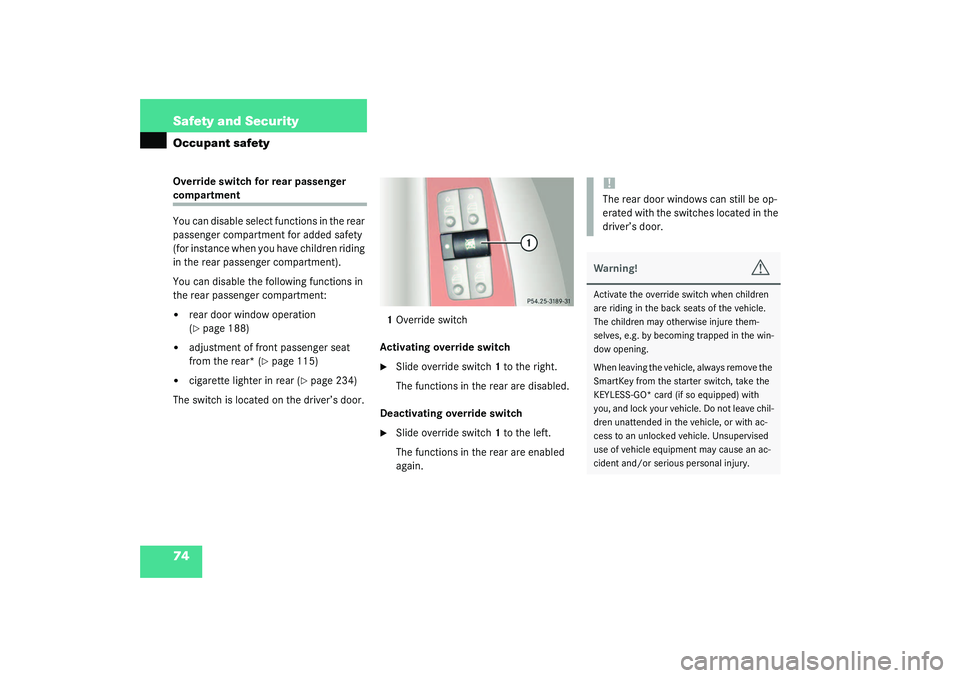
74 Safety and SecurityOccupant safetyOverride switch for rear passenger compartment
You can disable select functions in the rear
passenger compartment for added safety
(for instance when you have children riding
in the rear passenger compartment).
You can disable the following functions in
the rear passenger compartment:�
rear door window operation
(�page 188)
�
adjustment of front passenger seat
from the rear* (
�page 115)
�
cigarette lighter in rear (
�page 234)
The switch is located on the driver’s door.1Override switch
Activating override switch
�
Slide override switch 1 to the right.
The functions in the rear are disabled.
Deactivating override switch
�
Slide override switch 1 to the left.
The functions in the rear are enabled
again.
!The rear door windows can still be op-
erated with the switches located in the
driver’s door.Warning!
G
Activate the override switch when children
are riding in the back seats of the vehicle.
The children may otherwise injure them-
selves, e.g. by becoming trapped in the win-
dow opening.
When leaving the vehicle, always remove the
SmartKey from the starter switch, take the
KEYLESS-GO* card (if so equipped) with
you, and lock your vehicle. Do not leave chil-
dren unattended in the vehicle, or with ac-
cess to an unlocked vehicle. Unsupervised
use of vehicle equipment may cause an ac-
cident and/or serious personal injury.
Page 85 of 416
85 Controls in detail
Locking and unlocking
Seats
Memory function
Lighting
Instrument cluster
Control system
Automatic transmission
Good visibility
Automatic climate control
Power windows
Sliding/pop-up roof
Driving systems
Loading
Useful features
Page 104 of 416
104 Controls in detailSeats
SeatsInformation on seat adjustment can be
found in the “Getting started” section,
(�page 34).
Lumbar support
You can adjust the contour of the seat’s
lumbar support to best support your spine.
The thumbwheel is located on the lower
side of the seat.
1Thumbwheel�
Make sure the ignition is switched on.
All the lamps in the instrument cluster
should light up.
�
Set the lumbar support between 0
and 5.
Easy-entry/exit feature
With the easy-entry/exit feature activated,
the steering wheel tilts upwards and the
driver’s seat moves to the rear.
This allows easier entry into and exit from
the vehicle when the driver’s door is
opened. However, the engine must be
turned off.
When the SmartKey is inserted in the start-
er switch or you have pressed the
KEYLESS-GO* start/stop button once and
the driver’s door is closed, the steering
wheel and the driver’s seat return to their
last set positions.
Page 105 of 416
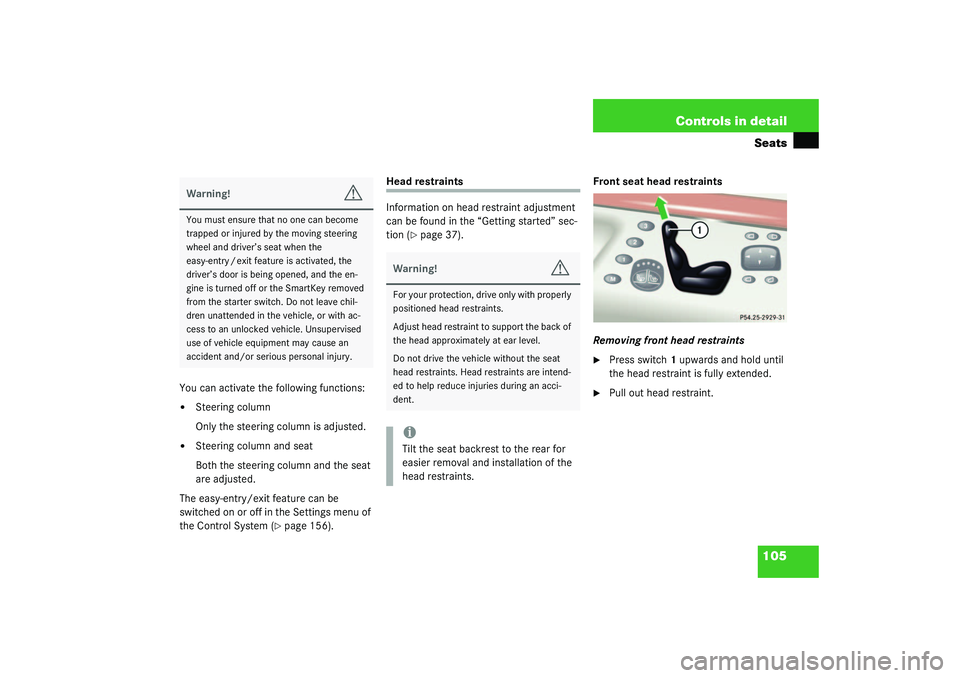
105 Controls in detailSeats
You can activate the following functions:�
Steering column
Only the steering column is adjusted.
�
Steering column and seat
Both the steering column and the seat
are adjusted.
The easy-entry/exit feature can be
switched on or off in the Settings menu of
the Control System (
�page 156).
Head restraints
Information on head restraint adjustment
can be found in the “Getting started” sec-
tion (
�page 37).Front seat head restraints
Removing front head restraints
�
Press switch1 upwards and hold until
the head restraint is fully extended.
�
Pull out head restraint.
Warning!
G
You must ensure that no one can become
trapped or injured by the moving steering
wheel and driver’s seat when the
easy-entry / exit feature is activated, the
driver’s door is being opened, and the en-
gine is turned off or the SmartKey removed
from the starter switch. Do not leave chil-
dren unattended in the vehicle, or with ac-
cess to an unlocked vehicle. Unsupervised
use of vehicle equipment may cause an
accident and/or serious personal injury.
Warning!
G
For your protection, drive only with properly
positioned head restraints.
Adjust head restraint to support the back of
the head approximately at ear level.
Do not drive the vehicle without the seat
head restraints. Head restraints are intend-
ed to help reduce injuries during an acci-
dent.iTilt the seat backrest to the rear for
easier removal and installation of the
head restraints.
Page 106 of 416
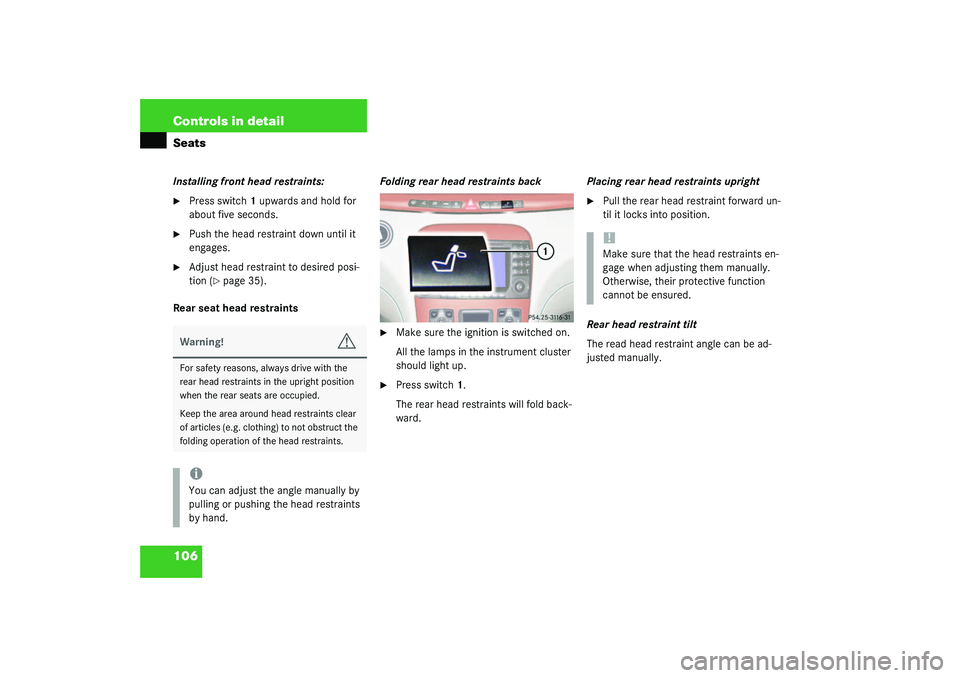
106 Controls in detailSeatsInstalling front head restraints:�
Press switch1 upwards and hold for
about five seconds.
�
Push the head restraint down until it
engages.
�
Adjust head restraint to desired posi-
tion (
�page 35).
Rear seat head restraintsFolding rear head restraints back
�
Make sure the ignition is switched on.
All the lamps in the instrument cluster
should light up.
�
Press switch1.
The rear head restraints will fold back-
ward.Placing rear head restraints upright
�
Pull the rear head restraint forward un-
til it locks into position.
Rear head restraint tilt
The read head restraint angle can be ad-
justed manually.
Warning!
G
For safety reasons, always drive with the
rear head restraints in the upright position
when the rear seats are occupied.
Keep the area around head restraints clear
of articles (e.g. clothing) to not obstruct the
folding operation of the head restraints.iYou can adjust the angle manually by
pulling or pushing the head restraints
by hand.
!Make sure that the head restraints en-
gage when adjusting them manually.
Otherwise, their protective function
cannot be ensured.
Page 107 of 416
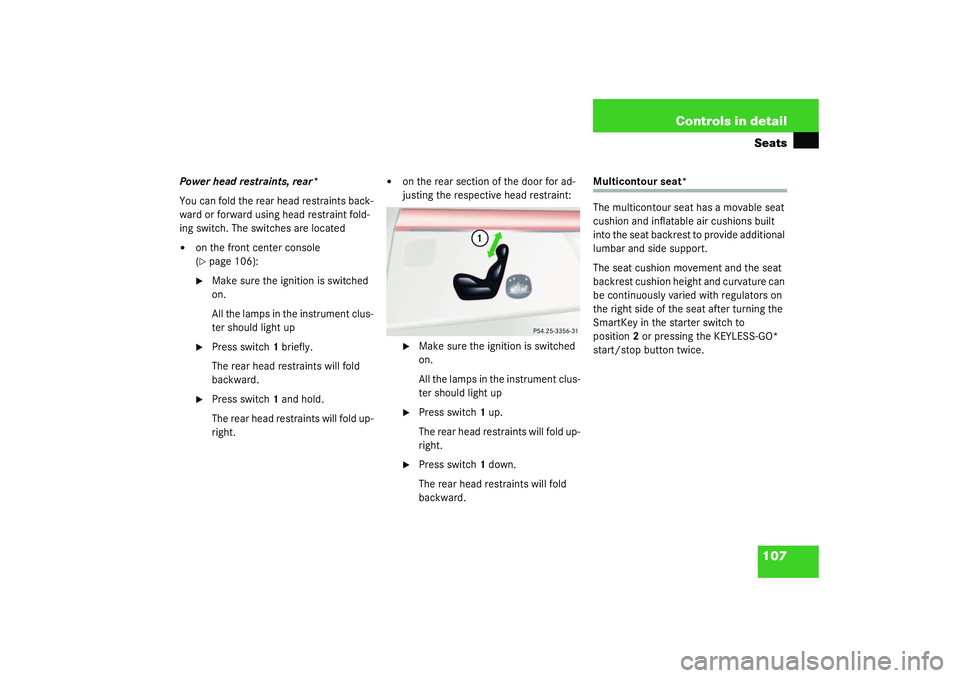
107 Controls in detailSeats
Power head restraints, rear*
You can fold the rear head restraints back-
ward or forward using head restraint fold-
ing switch. The switches are located�
on the front center console
(�page 106):
�
Make sure the ignition is switched
on.
All the lamps in the instrument clus-
ter should light up
�
Press switch1 briefly.
The rear head restraints will fold
backward.
�
Press switch1 and hold.
The rear head restraints will fold up-
right.
�
on the rear section of the door for ad-
justing the respective head restraint:�
Make sure the ignition is switched
on.
All the lamps in the instrument clus-
ter should light up
�
Press switch1 up.
The rear head restraints will fold up-
right.
�
Press switch1 down.
The rear head restraints will fold
backward.
Multicontour seat*
The multicontour seat has a movable seat
cushion and inflatable air cushions built
into the seat backrest to provide additional
lumbar and side support.
The seat cushion movement and the seat
backrest cushion height and curvature can
be continuously varied with regulators on
the right side of the seat after turning the
SmartKey in the starter switch to
position2 or pressing the KEYLESS-GO*
start/stop button twice.
Page 108 of 416
108 Controls in detailSeats1Shoulder region support
2Side bolster adjustment
3Massage function (PULSE)
4Lumbar region support
Adjusting the multicontour seat in the or-
der listed above is recommended.�
Make sure that the ignition is switched
on.
All lamps in the instrument cluster light
up.Shoulder region support
�
Press
æ
or
ç
on switch1.
The air cushion inflates or deflates.
Lumbar region support
�
Press
k
or
j
on rocker
switch4.
This selects the air cushion you wish to
adjust.
�
Press
æ
or
ç
on rocker
switch4.
The air cushion inflates or deflates.Side bolsters adjustment
�
Adjust the side bolsters so that they
provide good lateral support using
switch 2.iWhen the engine is turned off, the last
cushion setting is retained in memory
and the cushion is automatically ad-
justed to this setting when the engine
is restarted.
Page 109 of 416
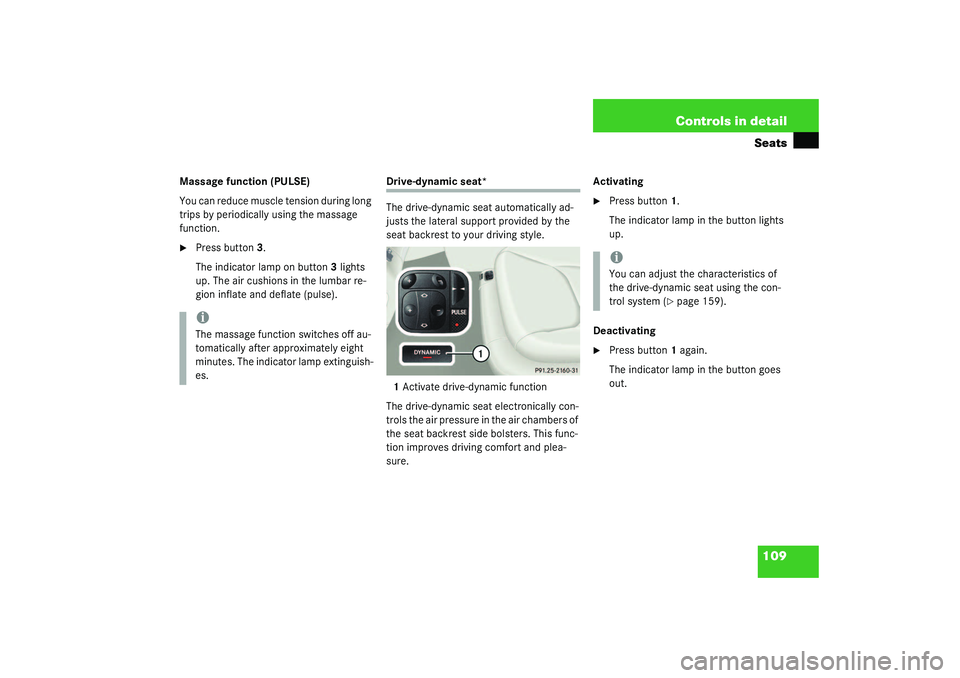
109 Controls in detailSeats
Massage function (PULSE)
You can reduce muscle tension during long
trips by periodically using the massage
function. �
Press button3.
The indicator lamp on button3 lights
up. The air cushions in the lumbar re-
gion inflate and deflate (pulse).
Drive-dynamic seat*
The drive-dynamic seat automatically ad-
justs the lateral support provided by the
seat backrest to your driving style.
1Activate drive-dynamic function
The drive-dynamic seat electronically con-
trols the air pressure in the air chambers of
the seat backrest side bolsters. This func-
tion improves driving comfort and plea-
sure.Activating
�
Press button1.
The indicator lamp in the button lights
up.
Deactivating
�
Press button1 again.
The indicator lamp in the button goes
out.
iThe massage function switches off au-
tomatically after approximately eight
minutes. The indicator lamp extinguish-
es.
iYou can adjust the characteristics of
the drive-dynamic seat using the con-
trol system (
�page 159).